
Sir Roger Vaughan (died 1471) of Tretower Court, was the son of Welsh noblewoman Gwladys ferch Dafydd Gam and Sir Roger Vaughan of Bredwardine, who fought and died with Gwladys's father, Dafydd Gam in the Battle of Agincourt in 1415. [1]

Sir Roger Vaughan (died 1471) of Tretower Court, was the son of Welsh noblewoman Gwladys ferch Dafydd Gam and Sir Roger Vaughan of Bredwardine, who fought and died with Gwladys's father, Dafydd Gam in the Battle of Agincourt in 1415. [1]
Roger was married three times. His first wife, Denise [2] (her name is sometimes given as Cicely), [3] daughter of Thomas ab Philip Vychan, of Talgarth, celebrated in one of the poems of Lewus Glyn Cothi, died not long after Roger's return from the Battle of Agincourt. She was the mother of his heir, Sir Thomas Vaughan, another son, Roger Vaughan of Porthaml, and four daughters, all of whom married into prominent Welsh families. [3]
He then married Margaret Tuchet, daughter of Lord Audley, [4] another of the English heroes of Agincourt and, later, Eleanor Holland, natural daughter of the Earl of Kent. They had one daughter, who married Humphrey Kynaston. [5] [6] [7] He was also alleged to have fathered a number of illegitimate children. [3]

During the series of dynastic civil wars known as the Wars of the Roses (1455–1485), loyalties in England were split between the House of Lancaster and the House of York. Roger's parents were loyal Lancastrians, and Roger fought with his father for Henry V of England at the Battle of Agincourt. In later years, though, Roger and his brothers Watkin and Thomas switched allegiances, becoming staunch Yorkists. [6]
Roger was given positions of responsibility and knighted by 23 March 1465 for his activities supporting the Yorkist faction: [1] [3]
Roger is thought to have received the fortified manor, Tretower Court, as a gift from his half-brother William Herbert, 1st Earl of Pembroke. [1]
In May 1471, Roger was sent by King Edward to capture Jasper Tudor; however, Roger instead fell into Jasper's hands and he was consequently beheaded at Chepstow, which resulted in further acrimonious sentiments towards the Tudors by the Vaughans and Herberts. [1]
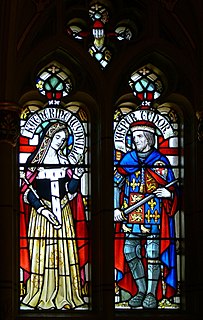
Jasper Tudor, Duke of Bedford and Earl of Pembroke, also called Jasper of Hatfield, was the uncle of King Henry VII of England and a leading architect of his nephew's successful accession to the throne in 1485. He was from the noble Tudor family of Penmynydd in North Wales.
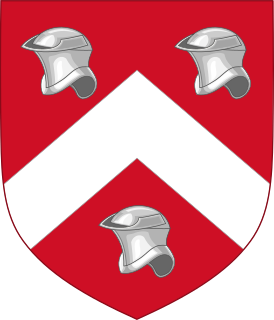
Sir Owen Tudor was a Welsh courtier and the second husband of Catherine of Valois (1401–1437), widow of King Henry V of England. He was the grandfather of Henry VII, founder of the Tudor dynasty.
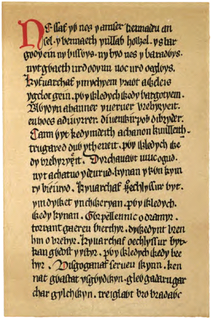
The Red Book of Hergest is a large vellum manuscript written shortly after 1382, which ranks as one of the most important medieval manuscripts written in the Welsh language. It preserves a collection of Welsh prose and poetry, notably the tales of the Mabinogion and Gogynfeirdd poetry. The manuscript derives its name from the colour of its leather binding and from its association with Hergest Court between the late 15th and early 17th century.

Sir William StanleyKG was an English soldier and the younger brother of Thomas Stanley, 1st Earl of Derby. Stanley fought with his troops in several battles of the Wars of the Roses.

Dafydd ap Llewelyn ap Hywel, better known as Dafydd Gam, anglicized to David or Davy Gam, was a Welsh warrior, a prominent opponent of Owain Glyndŵr. He died at the Battle of Agincourt fighting for Henry V, King of England in that victory against the French.
Sir Thomas Vaughan was a Welsh statesman and diplomat, who rose to prominence before and during the Wars of the Roses. He began as an adherent of Jasper Tudor and King Henry VI of England, and was appointed to several offices by Henry. He was nonetheless a Yorkist by inclination, as were many Welshmen of the time. After the Yorkist victory in 1461 he became a loyal and important servant of King Edward IV. In 1483, he was executed by Richard III as part of his seizure of the throne.

Sir William ap Thomas was a Welsh nobleman, politician, knight, and courtier. He was a member of the Welsh gentry family that came to be known as the Herbert family through his son William Herbert, 1st Earl of Pembroke and is the agnatic ancestor, via an illegitimate descendant of the 1st Earl of the 8th creation, of the current Herbert family of the Earl of Pembroke and Montgomery, and also of the Herbert Earl of Carnarvon.
Ednyfed Fychan, full name Ednyfed Fychan ap Cynwrig, was a Welsh warrior who became Seneschal to the Kingdom of Gwynedd in Northern Wales, serving Llywelyn the Great and his son Dafydd ap Llywelyn. Fychan claimed descent from Marchudd ap Cynan, Lord of Rhos, 'protector' of Rhodri Mawr, King of Gwynedd. He was the ancestor of Owen Tudor and thereby of the Tudor dynasty.
Lewys Glyn Cothi, also known as Llywelyn y Glyn, was a prominent 15th century Welsh poet who composed numerous poems in the Welsh language. He is one of the most important representatives of the Beirdd yr Uchelwyr or Cywyddwyr ("cywydd-men"), the itinerant professional poets of the period between the 1284 Statute of Rhuddlan and c. 1600.
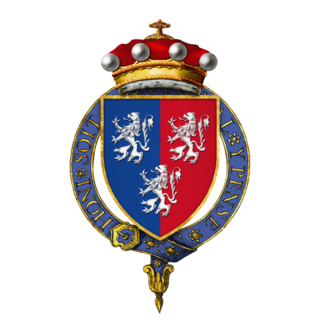
William Herbert, 1st Earl of PembrokeKG, known as "Black William", was a Welsh nobleman, soldier, politician, and courtier.
Guto'r Glyn was a Welsh language poet and soldier of the era of the Beirdd yr Uchelwyr or Cywyddwyr ("cywydd-men"), the itinerant professional poets of the later Middle Ages. He is considered one of the greatest exponents, if not the greatest, of the tradition of "praise-poetry", verse addressed to a noble patron.
Sir Gruffudd Vychan was a Welsh knight who supported the rebellion of Owain Glyndŵr against the English, captured the Lollard John Oldcastle and was finally executed after the murder of Sir Christopher Talbot.
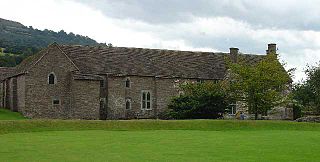
Tretower Court is a medieval fortified manor house in Wales, situated in the village of Tretower, near Crickhowell in modern-day Powys, previously within the historical county of Breconshire or Brecknockshire.
This article is about the particular significance of the century 1401–1500 to Wales and its people.

Sir Rhys ap Thomas (1449–1525) was a Welsh soldier and landholder who rose to prominence during the Wars of the Roses, and was instrumental in the victory of Henry Tudor at the Battle of Bosworth. He remained a faithful supporter of Henry and was rewarded with lands and offices in South Wales. Some sources claim that he personally delivered the death blow to King Richard III at Bosworth with his poleaxe.
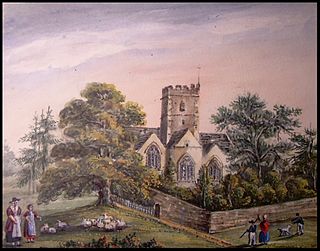
Gwladys ferch Dafydd Gam was a Welsh noblewoman. She was the daughter of Dafydd ap Llewelyn ap Hywel, otherwise known as Dafydd Gam, who was killed at the Battle of Agincourt in 1415.
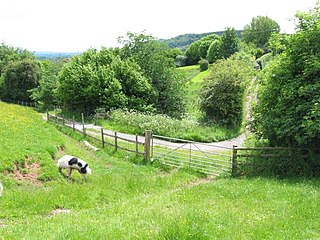
Sir Roger Vaughan of Bredwardine, also known as Roger Fychan or Roger the younger, was a Welsh gentleman, described as having possessed wealth, rank, and high respectability. Roger's seat, Bredwardine Castle, is estimated to have been a strong and formidable fortress, located on the banks of the Wye river in Herefordshire, two miles north of Moccas Court. Bredwardine Castle is thought to have furnished much of the material for the building of Moccas Court.
Roger Vaughan (1834–1883) was an English Benedictine monk of Downside Abbey and Roman Catholic Archbishop of Sydney, 1877–1883.

Sir Richard Herbert of Coldbrook Park, near Abergavenny, was a 15th-century Welsh knight, and the lineal ancestor of the Herberts of Chirbury.